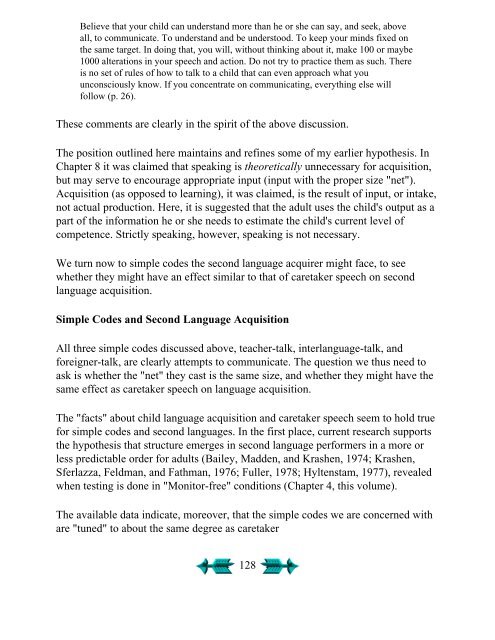Second Language Acquisition and Second ... - Stephen Krashen
Second Language Acquisition and Second ... - Stephen Krashen
Second Language Acquisition and Second ... - Stephen Krashen
You also want an ePaper? Increase the reach of your titles
YUMPU automatically turns print PDFs into web optimized ePapers that Google loves.
Believe that your child can underst<strong>and</strong> more than he or she can say, <strong>and</strong> seek, above<br />
all, to communicate. To underst<strong>and</strong> <strong>and</strong> be understood. To keep your minds fixed on<br />
the same target. In doing that, you will, without thinking about it, make 100 or maybe<br />
1000 alterations in your speech <strong>and</strong> action. Do not try to practice them as such. There<br />
is no set of rules of how to talk to a child that can even approach what you<br />
unconsciously know. If you concentrate on communicating, everything else will<br />
follow (p. 26).<br />
These comments are clearly in the spirit of the above discussion.<br />
The position outlined here maintains <strong>and</strong> refines some of my earlier hypothesis. In<br />
Chapter 8 it was claimed that speaking is theoretically unnecessary for acquisition,<br />
but may serve to encourage appropriate input (input with the proper size "net").<br />
<strong>Acquisition</strong> (as opposed to learning), it was claimed, is the result of input, or intake,<br />
not actual production. Here, it is suggested that the adult uses the child's output as a<br />
part of the information he or she needs to estimate the child's current level of<br />
competence. Strictly speaking, however, speaking is not necessary.<br />
We turn now to simple codes the second language acquirer might face, to see<br />
whether they might have an effect similar to that of caretaker speech on second<br />
language acquisition.<br />
Simple Codes <strong>and</strong> <strong>Second</strong> <strong>Language</strong> <strong>Acquisition</strong><br />
All three simple codes discussed above, teacher-talk, interlanguage-talk, <strong>and</strong><br />
foreigner-talk, are clearly attempts to communicate. The question we thus need to<br />
ask is whether the "net" they cast is the same size, <strong>and</strong> whether they might have the<br />
same effect as caretaker speech on language acquisition.<br />
The "facts" about child language acquisition <strong>and</strong> caretaker speech seem to hold true<br />
for simple codes <strong>and</strong> second languages. In the first place, current research supports<br />
the hypothesis that structure emerges in second language performers in a more or<br />
less predictable order for adults (Bailey, Madden, <strong>and</strong> <strong>Krashen</strong>, 1974; <strong>Krashen</strong>,<br />
Sferlazza, Feldman, <strong>and</strong> Fathman, 1976; Fuller, 1978; Hyltenstam, 1977), revealed<br />
when testing is done in "Monitor-free" conditions (Chapter 4, this volume).<br />
The available data indicate, moreover, that the simple codes we are concerned with<br />
are "tuned" to about the same degree as caretaker<br />
128











